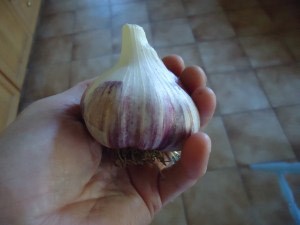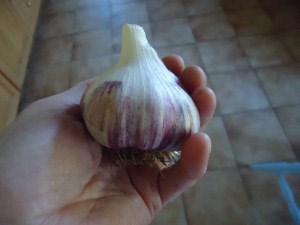
August in the kitchen garden is a time for change. Last month I harvested the garlic and onions so two beds were empty. What was I going to plant next? I had started some cauliflower seedlings in the greenhouse so they were ready to be planted out. It was time to go through my seeds to see what else I could plant for fall and winter crops. I want to have crops in the garden that I can harvest in late fall or store to eat during winter when food prices increase.
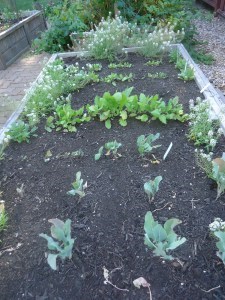
I decided to plant some turnips, purple sprouting broccoli, cabbage and kale with the cauliflowers seedlings. How did I know what I could plant now? I checked out the planting chart over at West Coast Seeds and looked for vegetables I could direct seed this month. It was that easy. My cauliflower seedlings are not looking so well this week. I may have planted them too early, a sign of an eager gardener. The rest of the plants are up and doing great.
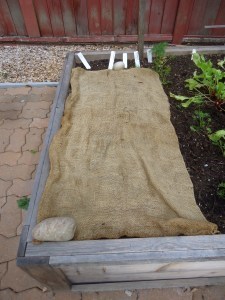
Once the seeds were planted, I carefully watered them as dried out seeds will not germinate. This is something you need to plant when you are at home, not just before you go on holidays. It’s important for seeds to have good contact with the soil and moisture to help soften the seed coat. I also planted carrots this month. I want to be able to have a few carrots in the garden over the winter. The last week was warmer than usual so I tried shading my newly planted carrot seeds with burlap. I made sure to water the seeds in well and placed the burlap over top and moistened it. When I came back the next morning the soil underneath was still moist. By the end of the week the carrot seeds had germinated and I was able to remove the burlap. Many seeds don’t germinate easily in hot weather and benefit from a shade cloth to get them going.
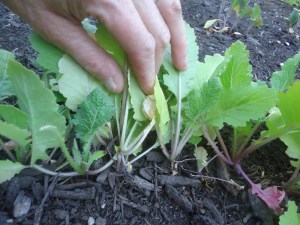
I look forward to harvesting turnips. They are so easy to grow. I will let them grow a bit before I do some thinning. Thinning is necessary if you accidentally plant too many seeds in one spot. You need to think about the final size of the vegetable you are growing. For example, I like to harvest turnips when they are about 1/12”-2” in size so I should have each plant that far apart for proper development of the turnip. If they are too crowded they may not grow properly. Did you know that the leaves of turnips are edible as well? The greens are best when picked young. Be sure to harvest turnip greens from your kitchen garden in the morning and cut them as you would lettuce as they are a ‘cut and come’ again leaf.
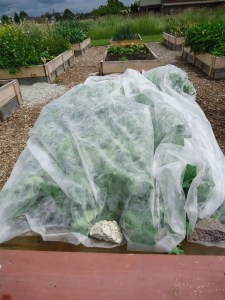
You will notice that most of the plants I sowed are all from the Brassica family. Growing them together makes crop rotation in the kitchen garden easier. The Brassica family of plants includes turnips, kale, cauliflower, cabbage, kohlrabi, broccoli and rutabaga. They also have the same pests. By planting them all together I can use a floating row cover to keep the cabbage moth from laying eggs on the plants. Floating row covers are great for pest prevention but they can make the garden warmer than it should be.
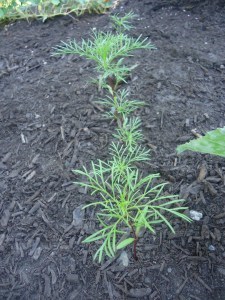
I harvested the onions and wasn’t sure what to plant in the empty raised bed. After another look at the planting list for July, I was delighted to see I could plant more Cosmos. While the blog was being created I supplied flowers for a wedding and made several bouquets. Cosmos are wonderful cut flowers.
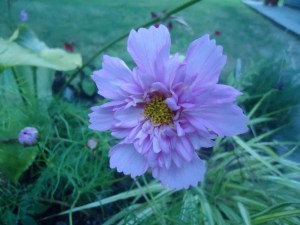
I planted Cosmos ‘Rose Bon Bon’ and ‘Double Click’. Both Cosmos are double petalled in shades of pink and white. I will have cut flowers well into the fall. They germinated easily despite the warm temperatures and are now about an inch high. I also planted some Scabiosa which is up as well.
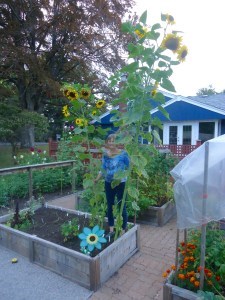
You are probably wondering why I keep planting. My motto is to never have bare soil. If you can grow more food, why not? After all, that’s why we built the kitchen garden.
